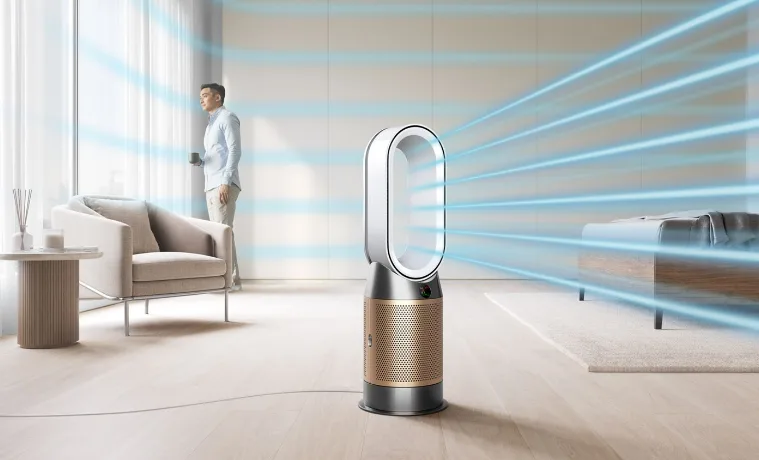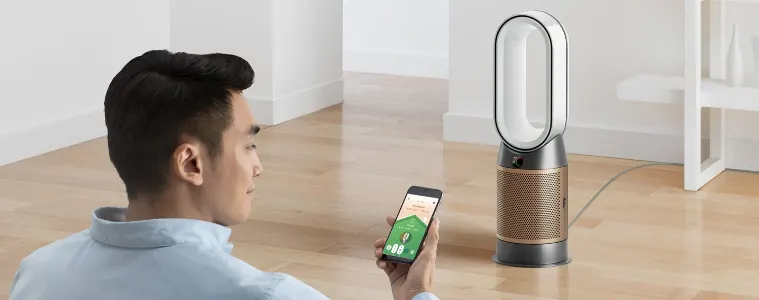ARTICLE
How To Choose The Best Air Purifier For Your Home
June 24, 2025-4 min read
Think the air inside your home is squeaky clean? Think again. From cooking fumes to harmful yet odourless gases produced by cleaning products, indoor air quality can be worse than you expect. Add pesky allergens such as pollen, pet dander and dust particles, and it’s smart to start thinking seriously about the air quality at your place.
That’s where a home air purifier steps in. But with so many models on the market to choose from, including some from high-tech, high-spec brands like Dyson, choosing the best air purifier for your family and your home can be a challenge. Here are a few things to get your head around – and keep in mind – so you can find your perfect fresh-air match.

“When it’s a brand that is famous for its tech, like Dyson for example, you know that the smart functions an air purifier rolls out will be genuine game changers – for you and your home’s air quality.” - Scott Bazley, The Good Guys Buyer – Seasonal.
”
How do air purifiers work?
First, they draw indoor air into various filters, which catch and trap the things you don’t want in the air. Then they push the cleaned, purified air – free of all those trapped nasties – out into the room so you can breathe easy. “We see a lot of customers with seasonal allergies shopping for air purifiers,” says Scott Bazley, The Good Guys Buyer – Seasonal. “But with many people becoming more health conscious and spending far more time at home for work and play these days, these air treatment appliances are becoming a household essential for everyone.”
Air purifier filter features to look for
High Efficiency Particulate Air (HEPA) filters are specifically designed to trap dust, pollen, mould spores, smoke, bacteria and other ultrafine particles. Rated on a scale from H10 to H14, the higher the filter’s ‘H’ rating, the better. For example, the Dyson Purifier Hot + Cool HP1 white/white removes 99.95% of particles as tiny as 0.1 microns from indoor air because it features a HEPA H13 filter that’s fully sealed, placing it in the highest tier of HEPA filtration. It also has an activated carbon filter. That’s to remove odours and potentially harmful gases from common household items such as cleaning sprays, aerosols, and gas cooktops when they’re in action. For that extra layer of purification and protection, the K-Carbon filter in the Dyson Purifier Hot + Cool HP2 De-Nox white/gold contains potassium carbonate, to continuously destroy formaldehyde and absorb 50 per cent more of the nitrogen dioxide that gas cooking and traffic create.*

Where to put your home air purifier
You’ll want it wherever you and your family are, or are going to be. That could be the kitchen, the living room, your home office or a bedroom – which means your air purifier needs to be lightweight so it’s easy to move. The complete Dyson purifier range has this box ticked. And they look great too, adding extra design cred to any room. Choose the Dyson Purifier Hot + Cool HP1 white/white for a chic, minimalist vibe or the Dyson Purifier Hot + Cool HP2 De-Nox white/gold for a touch of luxe.
The noise factor
Nothing zaps the zen at home quite like a noisy appliance, so it pays to consider how loud an air purifier is once it’s switched on. Both the HP1 and HP2 De-Nox Dyson hot and cool purifiers feature a Night Mode. Engineered to reduce turbulence and noise, it’s perfect for a good night’s sleep, or whenever you want to keep the volume down, whether you’re working from home or streaming your favourite show.
How fuss-free is the maintenance?
In order to keep pumping out purified air, the hard-working filters need replacing now and then, and the casing they live in should be cleaned regularly too. The last thing you want is for that to be a tricky task – but Dyson has you well and truly covered.How do you clean the filter on a Dyson? It’s simple: Just remove it from the air purifier, use a dry cloth to clean the filter’s casing, then use a soft brush to clear any blockages from the corresponding holes on the purifier. Replacing a dyson air purifier filter is quick and easy too. Plus, the LCD screen and the MyDyson app (that both the Dyson Purifier Hot + Cool HP1 white/white and the Dyson Purifier Hot + Cool HP2 De-Nox white/gold link to) let you know when it’s time for a filter change.

Are smart functions really worth it?
“When it’s a brand that is famous for its tech, like Dyson for example, you know that the smart functions an air purifier rolls out will be genuine game changers – for you and your home’s air quality,” says Scott Bazley. The perfect example is the Auto Mode on the HP1 and HP2 De-Nox Dyson hot and cool purifiers. When that’s activated, the purifier monitors air quality and reacts intuitively – instead of constantly – to remove pollutants and adjust airflow to save energy. You can also connect both Dyson purifiers with a compatible voice service, such as Alexa or Siri, to control it hands-free. And the handy MyDyson app lets you see exactly which pollutants have been captured and monitor your home’s air quality from absolutely anywhere.
What else can an air purifier do?
Do your research and the air purifier you bring home will do so much more than look after your indoor air quality. The Dyson Purifier Hot + Cool HP1 white/white and the Dyson Purifier Hot + Cool HP2 De-Nox white/gold both function like a Dyson fan, using exclusive Air Multiplier technology to cool you efficiently in summer. And in the cooler months, the purifiers’ ceramic plates, long-range projection and 350-degree oscillation quickly and evenly warm a whole room with less energy.
Ready to clear the air at your place with a Dyson air purifier? Head in-store or online to shop the range.
*Tested to Dyson test method TM-003387. In a 3 cubic meter test chamber, at fan speed 10, at third-party test laboratory (Fraunhofer WKI), comparison against regular activated carbon performance. Third party full machine testing based on GB/T 18801-2022 formaldehyde cumulative clean mass testing with continuous injection until plateau of formaldehyde CADR is achieved. Results may vary in practice.


